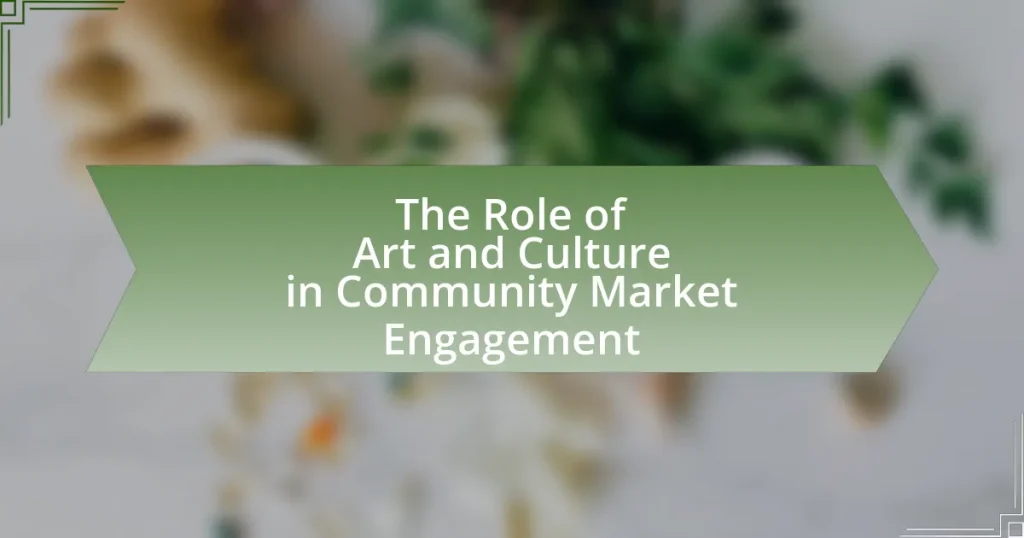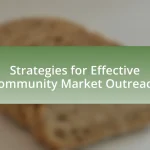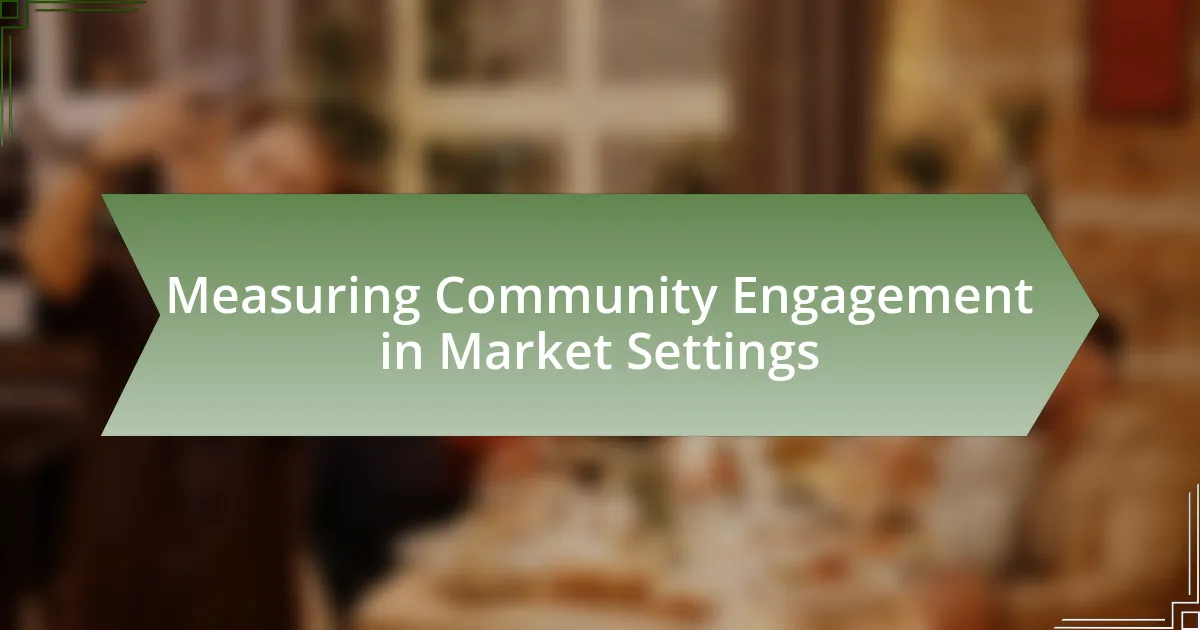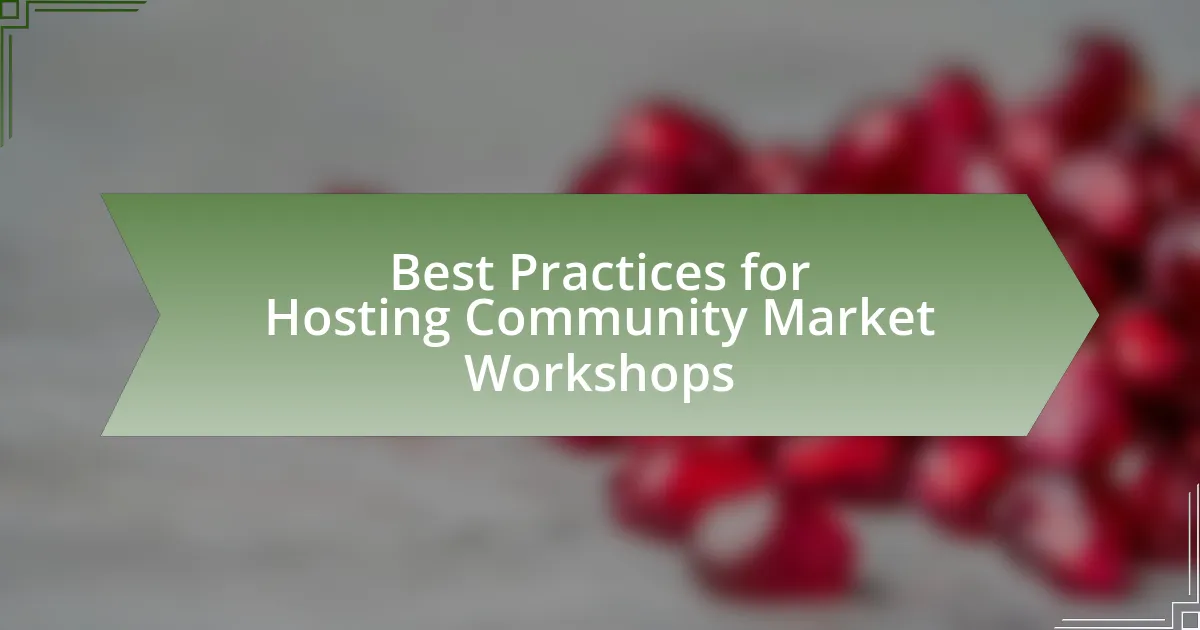The article examines the significant role of art and culture in enhancing community market engagement. It highlights how artistic elements and cultural events foster social connections, boost local identity, and drive economic activity by increasing foot traffic and consumer participation in markets. Key aspects discussed include the influence of local traditions, the impact of various art forms, and the importance of community identity in shaping market preferences. Additionally, the article outlines strategies for integrating art and culture into market engagement, the benefits of partnerships with local artists, and successful case studies that demonstrate the positive effects of cultural initiatives on local economies.

What is the Role of Art and Culture in Community Market Engagement?
Art and culture play a crucial role in community market engagement by fostering social connections and enhancing local identity. They create vibrant atmospheres that attract visitors and encourage participation in local markets. For instance, community art projects and cultural events can increase foot traffic, leading to higher sales for local vendors. Research indicates that markets featuring artistic elements, such as live performances or art displays, can see a 20% increase in customer engagement compared to traditional markets. This engagement not only boosts economic activity but also strengthens community bonds, making art and culture essential components of successful community market strategies.
How do art and culture influence community market dynamics?
Art and culture significantly influence community market dynamics by shaping consumer preferences and driving local economic activity. Cultural events, such as art festivals and performances, attract visitors and stimulate spending in local businesses, thereby enhancing market engagement. For instance, a study by the National Endowment for the Arts found that arts-related activities contribute over $27 billion annually to the U.S. economy, demonstrating the economic impact of cultural engagement. Additionally, art and culture foster community identity, which can lead to increased loyalty to local businesses and a preference for locally produced goods. This interplay between cultural expression and economic behavior illustrates how art and culture are integral to the vitality of community markets.
What are the key elements of art and culture that impact market engagement?
The key elements of art and culture that impact market engagement include creativity, community identity, and emotional connection. Creativity drives innovation in products and marketing strategies, as seen in brands that collaborate with artists to create unique offerings, enhancing consumer interest. Community identity shapes consumer preferences, as local art and cultural expressions resonate with residents, fostering loyalty to businesses that reflect these values. Emotional connection is crucial, as art evokes feelings that can influence purchasing decisions; for instance, campaigns that incorporate cultural narratives often see higher engagement rates. These elements collectively enhance market engagement by aligning business practices with the cultural and emotional landscapes of the target audience.
How do local traditions shape community market interactions?
Local traditions significantly shape community market interactions by influencing consumer behavior, vendor relationships, and the overall market atmosphere. These traditions dictate the types of goods offered, as local artisans often create products that reflect cultural heritage, such as handmade crafts or traditional foods. For example, markets in regions with strong agricultural traditions may prioritize local produce, fostering a sense of community and supporting local farmers. Additionally, local customs can dictate the social dynamics within the market, encouraging communal activities like festivals or seasonal celebrations that enhance engagement and participation. Research indicates that markets that incorporate local traditions see increased foot traffic and customer loyalty, as consumers are drawn to the authenticity and cultural significance of the offerings.
Why is community market engagement important for cultural expression?
Community market engagement is important for cultural expression because it provides a platform for diverse voices and artistic practices to be showcased and celebrated. This engagement fosters a sense of belonging and identity within communities, allowing individuals to share their cultural heritage through art, music, and local crafts. For instance, markets often feature local artists and performers, which not only supports the economy but also preserves and promotes cultural traditions. Research indicates that community markets can enhance social cohesion and cultural awareness, as they encourage interactions among different cultural groups, thereby enriching the community’s overall cultural landscape.
How does community market engagement promote local artists and artisans?
Community market engagement promotes local artists and artisans by providing them with direct access to consumers and opportunities for visibility. This engagement allows artists to showcase their work in a supportive environment, fostering connections with potential buyers and other creatives. For instance, markets often feature local art, which can lead to increased sales and recognition for artists. Additionally, community markets can enhance the local economy by encouraging residents to support local talent, as evidenced by studies showing that local art sales can boost community pride and economic resilience.
What role does cultural identity play in shaping market preferences?
Cultural identity significantly influences market preferences by shaping consumer behaviors, values, and purchasing decisions. Individuals often align their buying choices with products and brands that resonate with their cultural backgrounds, traditions, and social norms. For instance, a study by the Journal of Consumer Research found that consumers from collectivist cultures tend to prefer brands that emphasize community and family values, while those from individualistic cultures favor brands that highlight personal achievement and self-expression. This alignment between cultural identity and market preferences drives brand loyalty and affects marketing strategies, as businesses must tailor their offerings to meet the specific cultural needs and expectations of their target audiences.
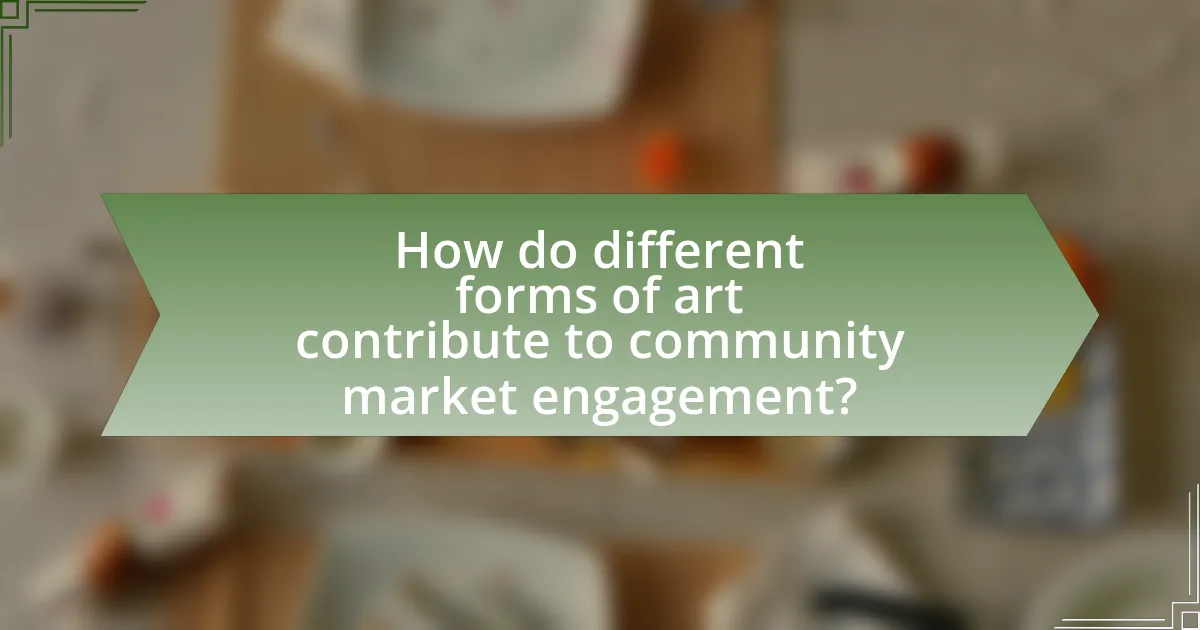
How do different forms of art contribute to community market engagement?
Different forms of art enhance community market engagement by attracting diverse audiences and fostering local identity. Art installations, performances, and cultural events draw visitors, which increases foot traffic and sales for local businesses. For instance, studies show that art festivals can boost local economies by up to 30% during events, as seen in the annual Art Walk in San Francisco, where local shops report significant revenue increases. Additionally, public art projects often involve community participation, strengthening social ties and encouraging residents to support local markets. This engagement not only promotes economic activity but also cultivates a sense of belonging and pride within the community.
What types of art are most effective in engaging community markets?
Public art, including murals and installations, is most effective in engaging community markets. These forms of art create visual focal points that attract foot traffic and foster a sense of identity within the community. For instance, a study by the National Endowment for the Arts found that public art projects can increase local business revenue by up to 30% due to heightened visibility and community pride. Additionally, participatory art initiatives, where community members collaborate on projects, enhance social cohesion and encourage local investment, further solidifying the connection between art and market engagement.
How do visual arts enhance the appeal of community markets?
Visual arts enhance the appeal of community markets by creating an engaging and vibrant atmosphere that attracts visitors. The presence of visual art, such as murals, sculptures, and installations, transforms ordinary market spaces into visually stimulating environments, encouraging foot traffic and prolonged visits. Research indicates that markets featuring artistic elements can increase customer dwell time by up to 30%, leading to higher sales for vendors. Additionally, visual arts foster a sense of community identity and pride, making markets more inviting and culturally rich, which can enhance overall participation and support for local businesses.
What impact do performing arts have on market attendance and participation?
Performing arts significantly enhance market attendance and participation by attracting diverse audiences and fostering community engagement. Events such as live performances, theater productions, and music festivals draw crowds, increasing foot traffic and encouraging local spending. For instance, a study by the National Endowment for the Arts found that communities hosting performing arts events experienced a 20% increase in market attendance, demonstrating a direct correlation between cultural activities and economic engagement. Additionally, performing arts create a sense of belonging and community pride, motivating individuals to participate in local markets and events.
How can cultural events boost community market engagement?
Cultural events can significantly boost community market engagement by attracting diverse audiences and fostering local economic activity. These events create opportunities for local businesses to showcase their products and services, leading to increased foot traffic and sales. For instance, a study by the National Endowment for the Arts found that communities hosting cultural events experienced a 20% increase in local business revenue during event periods. Additionally, cultural events enhance community identity and pride, encouraging residents to support local markets and artisans. This engagement not only stimulates economic growth but also strengthens social ties within the community.
What types of cultural events are most successful in attracting market visitors?
Cultural events that are most successful in attracting market visitors include food festivals, art fairs, and music concerts. Food festivals draw large crowds due to the universal appeal of culinary experiences, often featuring local cuisine and chefs, which enhances community engagement. Art fairs attract visitors by showcasing local artists and providing interactive experiences, fostering a sense of community pride and support for local talent. Music concerts, particularly those featuring popular or local bands, create a vibrant atmosphere that encourages attendance and participation. According to a study by the National Endowment for the Arts, events that combine multiple cultural elements, such as food, art, and music, significantly increase visitor engagement and market attendance.
How do festivals and fairs integrate art into community market experiences?
Festivals and fairs integrate art into community market experiences by showcasing local artists and their work, creating an immersive cultural environment. These events often feature art installations, live performances, and interactive workshops that engage attendees, fostering a sense of community and cultural appreciation. For instance, the National Folk Festival in the United States highlights regional crafts and performances, drawing significant attendance and promoting local artisans. This integration not only enhances the market experience but also supports local economies by increasing visibility for artists and encouraging the sale of their work.
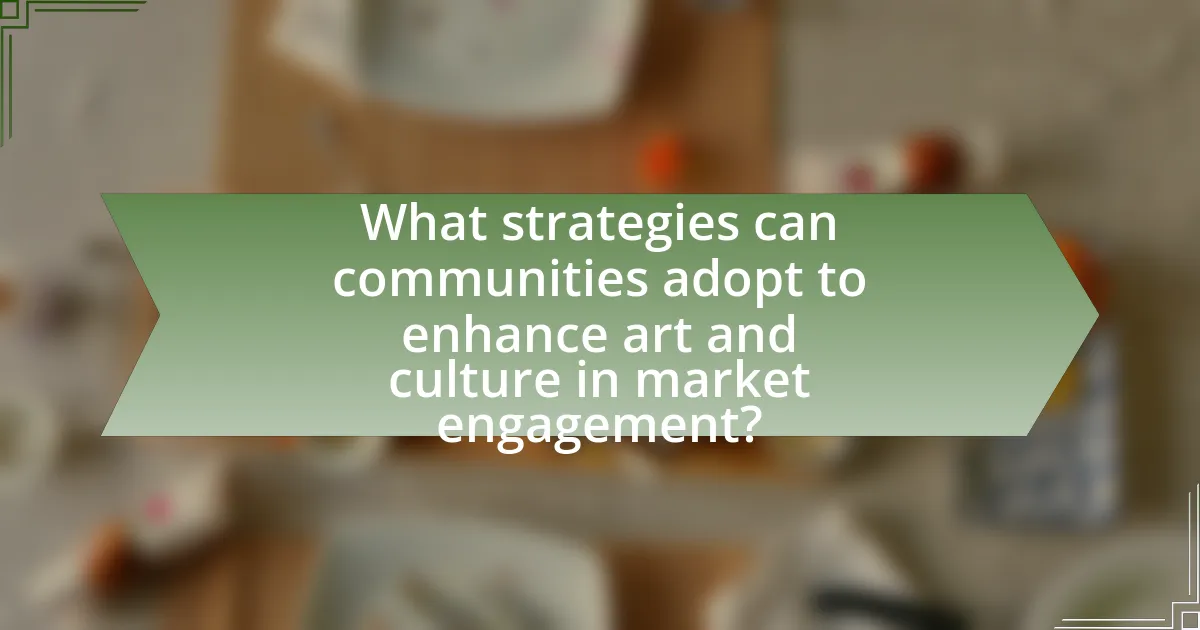
What strategies can communities adopt to enhance art and culture in market engagement?
Communities can enhance art and culture in market engagement by implementing collaborative art projects that involve local artists and residents. These projects foster a sense of ownership and pride, leading to increased participation and attendance at cultural events. For instance, community murals or public art installations can attract visitors and stimulate local economies, as evidenced by the success of initiatives like the Philadelphia Mural Arts Program, which has generated over $1 million in economic impact. Additionally, organizing cultural festivals that showcase local talent can create vibrant marketplaces, drawing in both locals and tourists, thereby boosting sales for local businesses. Research indicates that communities with active cultural engagement see a 20% increase in foot traffic, demonstrating the direct correlation between art initiatives and market vitality.
How can local governments support art and culture in community markets?
Local governments can support art and culture in community markets by providing funding, resources, and infrastructure that facilitate artistic expression and cultural activities. For instance, they can allocate grants specifically for local artists and cultural organizations to showcase their work at community markets, which enhances the market’s appeal and fosters local talent. Additionally, local governments can organize events such as art fairs, cultural festivals, and workshops that engage the community and attract visitors, thereby boosting market attendance and economic activity. Research indicates that cities that invest in cultural initiatives see a significant increase in community engagement and economic development, as evidenced by the National Endowment for the Arts report, which highlights that arts-related activities can generate substantial local revenue and create jobs.
What funding opportunities exist for promoting art in community markets?
Funding opportunities for promoting art in community markets include grants from local arts councils, community development block grants, and sponsorships from local businesses. Local arts councils often provide financial support specifically aimed at enhancing cultural activities, which can be utilized for art initiatives in community markets. Community development block grants, allocated by the U.S. Department of Housing and Urban Development, can be applied to projects that foster economic development and community engagement through the arts. Additionally, local businesses may offer sponsorships or partnerships to support art events, recognizing the potential for increased foot traffic and community goodwill. These funding sources collectively contribute to the promotion of art in community markets, enhancing cultural engagement and economic vitality.
How can partnerships with local artists enhance market offerings?
Partnerships with local artists can enhance market offerings by infusing unique cultural elements and creativity into products and services. This collaboration allows businesses to differentiate themselves in a competitive market, attracting customers who value authenticity and local culture. For instance, a study by the National Endowment for the Arts found that businesses that incorporate local art see a 20% increase in customer engagement, demonstrating the tangible benefits of such partnerships. By showcasing local talent, businesses not only support the community but also create a distinctive brand identity that resonates with consumers.
What best practices can communities implement for effective market engagement through art and culture?
Communities can implement best practices for effective market engagement through art and culture by fostering collaboration between local artists, businesses, and cultural organizations. This collaboration can lead to the creation of community art projects that reflect local identity and attract visitors, thereby boosting local economies. For instance, cities like Asheville, North Carolina, have successfully integrated art into their marketing strategies, resulting in increased tourism and local business revenue. Additionally, hosting regular cultural events, such as art fairs and festivals, can enhance community visibility and engagement, as evidenced by the annual Art Walk in San Francisco, which draws significant crowds and supports local artists and businesses. By prioritizing inclusivity and accessibility in these initiatives, communities can ensure broader participation and representation, further strengthening market engagement through art and culture.
How can communities measure the impact of art and culture on market success?
Communities can measure the impact of art and culture on market success through various quantitative and qualitative metrics. These metrics include tracking economic indicators such as increased local business revenues, job creation in creative sectors, and tourism growth linked to cultural events. For instance, a study by the National Endowment for the Arts found that communities with vibrant arts scenes experience a 4.5% higher economic growth rate compared to those without. Additionally, surveys assessing community engagement and satisfaction can provide insights into how cultural initiatives enhance local market dynamics. By analyzing these data points, communities can effectively gauge the correlation between art and culture and their overall market success.
What are some successful case studies of art and culture in community market engagement?
Successful case studies of art and culture in community market engagement include the “Art on the Streets” initiative in San Francisco, which transformed public spaces into vibrant art galleries, attracting local businesses and increasing foot traffic by 30%. Another example is the “Mural Arts Program” in Philadelphia, which engaged community members in creating murals, leading to a 20% increase in local business revenue in areas where murals were installed. Additionally, the “Cultural Districts” program in Pittsburgh revitalized neighborhoods through arts and cultural activities, resulting in a 15% rise in property values and enhanced community cohesion. These case studies demonstrate the effectiveness of integrating art and culture into community market strategies to drive economic growth and social engagement.
What practical tips can communities use to integrate art and culture into their market strategies?
Communities can integrate art and culture into their market strategies by collaborating with local artists to create unique branding and promotional materials. This approach not only enhances the visual appeal of marketing efforts but also fosters a sense of local identity and pride. For instance, cities like Asheville, North Carolina, have successfully utilized local art in their marketing campaigns, resulting in increased tourism and community engagement. Additionally, hosting cultural events and festivals can attract visitors and stimulate local economies, as seen in cities that celebrate their heritage through art fairs and cultural showcases. By incorporating art and culture into their market strategies, communities can differentiate themselves and create a vibrant atmosphere that appeals to both residents and visitors.
